Soil Science Society of America
5585 Guilford Road • Madison, WI 53711-5801 • 608-273-8080 • Fax 608-273-2021
www.soils.org
Twitter | Facebook
NEWS RELEASE
Contact: Hanna Jeske, Associate Director of Marketing and Brand Strategy, 608-268-3972, hjeske@sciencesocieties.org
When “soil” isn’t soil
October 7, 2015 - When you travel down a road, poor infrastructure and maintenance becomes more than a nuisance—it is a hazard. The same is true with indoor potting soils. The right choice with good maintenance makes all the difference.
 As an horticulture advisor and expert on potting soils, Bill Carlile explains it this way: “A good road surface allows cars and trucks to run well without damage or slowing down. Equally, a good potting ‘soil’ allows good, constant plant growth,” he says. ”’Badly structured potting soil is like a road with potholes that can damage cars; it can hinder plant growth. Equally, poorly fertilized potting soils, like inferior gas in trucks and cars, may lead to poor performance and damage."
As an horticulture advisor and expert on potting soils, Bill Carlile explains it this way: “A good road surface allows cars and trucks to run well without damage or slowing down. Equally, a good potting ‘soil’ allows good, constant plant growth,” he says. ”’Badly structured potting soil is like a road with potholes that can damage cars; it can hinder plant growth. Equally, poorly fertilized potting soils, like inferior gas in trucks and cars, may lead to poor performance and damage."
Truthfully, many potting soils aren’t “soils” at all, but a mix of ingredients. Together, these ingredients can smooth the road to good plant growth.
“Good potting soils have an open structure, allowing air to the roots, but at the same time retaining water, essential for plant growth,” Carlile explains. "Of course, they need added plant foods, and need to have a suitable pH, the balance between acid and alkaline conditions."
Home gardeners may be tempted to simply fill their pots with soil from their yard. “We don’t raise potted plants in backyard muck,” Carlile cautions, “because of poor structure, lack of nutrients, weed growth from seeds in soil, and diseases and pests lurking there.”
Peat is currently a major component of many potting soil blends. Peat is the layered accumulation of partially degraded organic material over hundreds of years. But in some parts of the world, peatland habitats are shrinking. The harvest of peat may also release additional carbon, contributing to climate change. Efforts are underway to find suitable replacements—a considerable challenge given the airy, absorptive nature of peat that is ideal for plant growth.
 Carlile, who works in Ireland at Bord na Mona (translated as “Peat Board”), is no stranger to this challenge.
Carlile, who works in Ireland at Bord na Mona (translated as “Peat Board”), is no stranger to this challenge.
“In this quest for peat replacements, researchers have looked at a vast range of organic materials. With one major exception, all materials so far have been considered as additions rather than direct replacements. It has proved almost impossible to find a material for use in potting soils that is as readily available at the same cost and with the same physical and benign chemical and microbiological properties as peat.”
That one exception? Coir. Formerly regarded as a waste product, coir (pronounced “koi-er”) is the outer husk of coconuts. Sri Lanka, India, Mexico, and Costa Rica have made this a valued export to European and North American markets. Once the husks are washed to remove natural salts, coir is dried and compressed. In the country of import, it can be wetted and it then swells to make a good potting soil base.
“Because it wets up and retains water well, it’s even better than peat for some uses, especially cuttings from plants,” Carlile says. “In Europe it’s becoming the potting soil of choice for the rapidly expanding strawberry market. The cost of coir, however, is at least twice that of peat.”
Bark and shredded wood fiber are other options. They are lightweight and easy to transport. But their age may affect their usefulness. “One of the problems in using wood fiber and bark is its ability to mop up nitrogen added as part of the fertilizer package,” Carlile says. Without access to the necessary nitrogen, plants suffer.
Other composted materials are valued as mulches, but can be deadly to young plants if not properly matured. “Raw composted materials can be drastically harmful, where seeds and young plants may be killed,” says Carlile.
Som e solutions may be as close as the waste pile. Bord na Mona has created an aged compost blend of green waste (anything from grass clipping to shredded trees), dairy plant sludge, and brewery grain waste with peat that provides a good balance. “Here organic wastes, some with major problems of disposal, have been transformed into a valuable resource that has received many compliments for its quality, with the additional benefit of reducing landfill problems: a triple win!” Carlile says.
e solutions may be as close as the waste pile. Bord na Mona has created an aged compost blend of green waste (anything from grass clipping to shredded trees), dairy plant sludge, and brewery grain waste with peat that provides a good balance. “Here organic wastes, some with major problems of disposal, have been transformed into a valuable resource that has received many compliments for its quality, with the additional benefit of reducing landfill problems: a triple win!” Carlile says.
But raw materials for potting soils are needed in bulk. One material sold in the United Kingdom.K had its base in recycled tea bags. However, no matter how much tea the English drink, there will not be enough tea bags to supply the potting soil market. Other options still exist, Carlile says. “Interestingly, a huge amount of coffee grounds go annually to landfills in the USA and Europe, and in mixture with peat and other materials, coffee grounds can produce a very effective growing medium.”
Composted wastes of human and animal origin, charmingly nicknamed “night soils,” may also be included in potting soil as biosolids. Proper treatment, however, is key to avoid human pathogens. Some municipalities in the United States sell "biosolids" after applying a pathogen-fighting combination of helpful bacteria and high temperatures in compliance with biosolid safety standards.
Finding a long-term replacement for peat remains an important environmental goal, but a lot of material of good quality is needed to make a good potting soil.
Carlile urges caution—and careful consideration of the plant’s stage of life. “Seedlings and young plants may be stunted in an inferior potting soil, but mature specimens may still grow. Very badly produced potting soil may reduce growth or in some cases even kill plants.”
On the road of plant growth, that is clearly a wrong turn.
Read more in Vadose Zone Journal.
Vadose Zone Journal is an international, gold open access journal that serves as an outlet for interdisciplinary research and assessment of the vadose zone, the portion of the critical zone that comprises the earth's critical living surface down to groundwater.